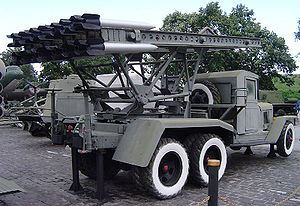The Katyusha rocket launcher - simple yet effective (but also took ages to load and was generally inaccurate). But like a huge shotgun, if your enemy is bunched up - they're going to hit something!
Compared to other artillery, these multiple rocket launchers delivered a devastating amount of explosives to a target area quickly, but with lower accuracy and requiring a longer time to reload. They were fragile compared to artillery guns, but also cheap and easy to produce.
They were usually mounted on trucks. This mobility gave the Katyusha (and other self-propelled artillery) another advantage: being able to deliver a large blow all at once, and then move before being located and attacked with counter-battery fire.
 |
| Katyusha's firing. No need to move this lot - the Germans will never know where the rockets came from! |
Katyusha rocket launchers were mounted on many platforms during World War II, including on trucks, artillery tractors, tanks, and armoured trains, as well as on naval and riverine vessels as assault support weapons, Soviet engineers also mounted single Katyusharockets on lengths of railway track to serve in urban combat.
The design was relatively simple, consisting of racks of parallel rails on which rockets were mounted, with a folding frame to raise the rails to launch position. Each truck had between 14 and 48 launchers. The M-13 rocket of the BM-13 system was 180 cm (5 ft 11 in) long, 13.2 cm (5.2 in) in diameter and weighed 42 kg (93 lb).
 |
| Completely unnecessary picture of a Russian babe. Perhaps her name IS Katy! |
The weapon is less accurate than conventional artillery guns, but is extremely effective in saturation bombardment, and was particularly feared by German soldiers. A battery of four BM-13 launchers could fire a salvo in 7–10 seconds that delivered 4.35 tons of high explosives over a 400,000-square-metre (4,300,000 sq ft) impact zone.
With an efficient crew, the launchers could redeploy to a new location immediately after firing, denying the enemy the opportunity for counterbattery fire.Katyusha batteries were often massed in very large numbers to create a shock effect on enemy forces. The weapon's disadvantage was the long time it took to reload a launcher, in contrast to conventional guns which could sustain a continuous low rate of fire.
Pretty much every WW2 wargamer is aware of this Russian beasty. But do you know where the name actually came from? After all, the official designations was BM-13.
Initially, concerns for secrecy kept their military designation from being known by the soldiers who operated them. They were called by code names such as Kostikov guns (after the head of the RNII - the Reaction-Engine Scientific Research Institute), and finally classed as Guards Mortars.
The name BM-13 (the standard version) was only allowed into secret documents in 1942, and remained classified until after the war.
Because they were marked with the letter K (for Voronezh Komintern Factory), Red Army troops adopted a nickname from Mikhail Isakovsky's popular wartime song, "Katyusha" (Little Kate) about a girl longing for her absent beloved, who has gone away on military service. The song was sung during the war by Lidiya Rusanova, the 'forces sweetheart' who reportedly paid for two batteries herself!
 |
| Lidia Rusanova. No, I wouldn't either. |
German troops however called them Stalin's organ (Stalinorgel), for its visual resemblance to a church musical organ and alluding to the sound of the weapon's rockets. They are known by the same name in Denmark (Danish:Stalinorgel), Finland (Finnish: Stalinin urut), France (Orgues de Staline), Norway (Stalinorgel), the Netherlands (Stalins orgel), Hungary (Sztálinorgona), and in Sweden.
The heavy BM-31 launcher was also referred to as Andryusha (a diminutive of “Andrew”). But in fact, only the Soviet press used this name.
